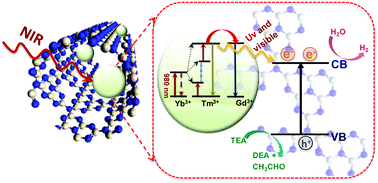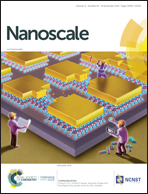Efficient upconverting carbon nitride nanotubes for near-infrared-driven photocatalytic hydrogen production†
Abstract
We report a facile chemical technique for synthesizing nanotube-based hybrid materials for near-infrared-driven photocatalytic hydrogen (H2) production. Upconversion nanoparticles (UCNPs), NaYF4:Yb,Tm,Gd (NYFG) and NaYF4:Yb,Tm (NYF), were engineered on C3N4 nanotubes (C3N4 NTs) separately to construct heterojunction structures. With a UCNP loading content of 15 wt%, the NYFG/C3N4 NT heterojunction exhibits the highest H2 generation rate of 311.6 μmol g−1 with an apparent quantum efficiency of 0.80 ‰, about 1.4 times higher than that of the NYF/C3N4 NT nanocomposite under 980 nm laser irradiation. Comprehensive characterization reveals that the enhanced photocatalytic performance of the Gd doped nanostructure is attributed to the synergistic effect, stronger interaction, higher emission intensities, and faster charge transfer between the UCNPs and C3N4 NTs. Moreover, the steady-state and dynamic fluorescence spectra indicate that the energy from NYFG NPs was transferred to C3N4 NTs via a fluorescence–resonance energy-transfer process. Our work demonstrates the potential of developing near-infrared-responsive photocatalysts for energy and environmental applications.



 Please wait while we load your content...
Please wait while we load your content...